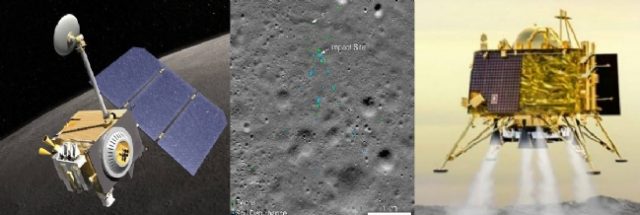
Nearly 3 months after ISRO’s Chandrayaan-2 reached the moon, the Vikram Lander which was lost during the descent phase along with the rover has been found. NASA’s moon mission which was orbiting the moon has found the debris of the lander. The US space agency made the announcement earlier today and has released the image taken by its Lunar Reconnaissance Orbiter (LRO) that showed the site of the spacecraft’s impact.
Interestingly it was a Chennai based Mechanical Engineer Shanmuga Subramanian who alerted NASA about the debris as being that of the Vikram Lander. NASA confirmed Subramanian’s suspicions and confirmed that the debris was indeed of the Vikram Lander.
The image released by NASA shows the Vikram Lander impact point and associated debris field. NASA has said that the Green dots indicate spacecraft debris and the Blue dots locate disturbed soil which are likely where small bits of the spacecraft churned up the regolith (solid material from moon surface).
NASA credits Chennai Engineer

NASA has credited Chennai based Mechanical Shanmuga Subramanian for finding Vikram Lander on Moon’s surface. The debris first located by Shanmuga is about 750 meters northwest of the main crash site and was a single bright pixel identification in that first mosaic.
Shanmuga Subramanian contacted the LRO project with a positive identification of debris. After receiving this tip, the LROC team confirmed the identification by comparing before and after images.
NASA has said that when the images for the first mosaic were acquired the impact point was poorly illuminated and thus not easily identifiable. Two subsequent image sequences were acquired on Oct. 14 and 15, and Nov. 11. The LROC team scoured the surrounding area in these new mosaics and found the impact site (70.8810°S, 22.7840°E, 834 m elevation) and associated debris field. The November mosaic had the best pixel scale (0.7 meter) and lighting conditions (72° incidence angle).

The Lunar Reconnaissance Orbiter Camera team released the first mosaic (acquired Sept. 17) of the site on Sept. 26 and many people have downloaded the mosaic to search for signs of Vikram. The November mosaic shows best the impact crater, ray and extensive debris field. The three largest pieces of debris are each about 2×2 pixels and cast a one pixel shadow.
Shanmuga Subramanian spoke to AFP news agency and said, “I had side-by-side comparison of those two images on two of my laptops… on one side there was the old image, and another side there was the new image released by NASA.” He also told he was helped by fellow Twitter and Reddit users.
The Chandrayaan 2 Vikram lander was targeted for a highland smooth plain about 600 kilometers from the south pole. Unfortunately ISRO lost contact with their lander shortly before the scheduled touchdown. NASA had commended ISRO and said that despite the loss, getting that close to the surface was an amazing achievement.














